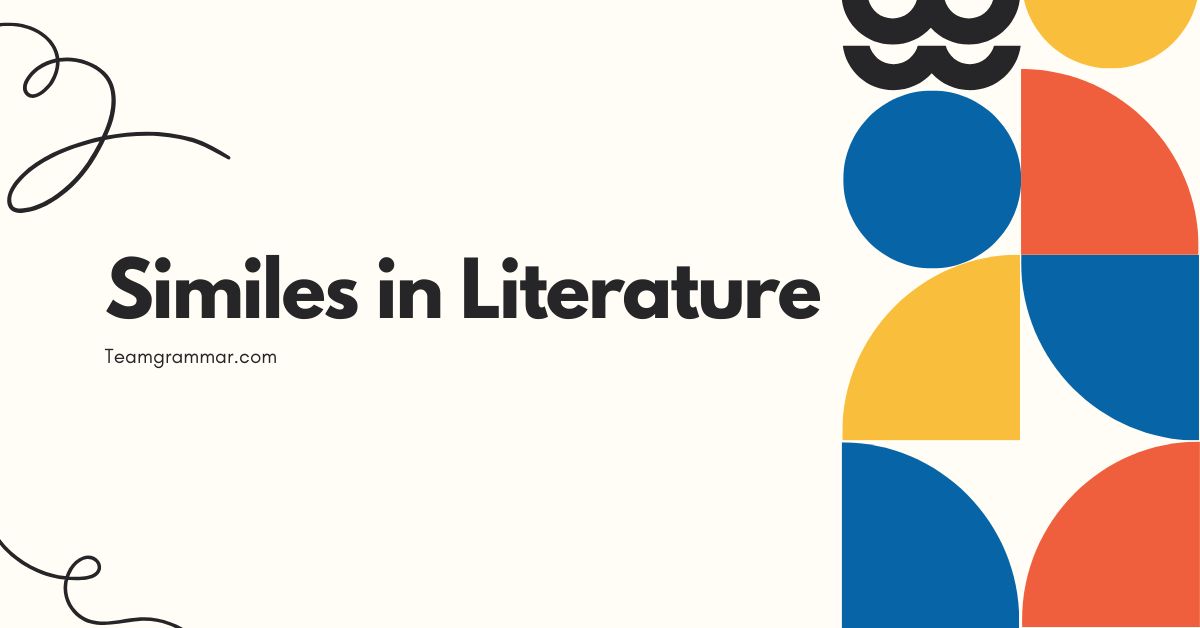37 Similes in Literature: Definition, Examples, & Usage
Similes are powerful literary devices that enrich writing by creating vivid comparisons. They allow authors to paint pictures with words, making abstract concepts more concrete and engaging readers on a deeper level.
Understanding similes is crucial for both analyzing literature and crafting compelling prose. This article provides a comprehensive guide to similes, exploring their definition, structure, types, and usage, with numerous examples from literature.
This resource will benefit students, writers, and anyone interested in enhancing their understanding of figurative language.
Table of Contents
- Definition of Simile
- Structural Breakdown of a Simile
- Types of Similes
- Examples of Similes in Literature
- Usage Rules for Similes
- Common Mistakes When Using Similes
- Practice Exercises
- Advanced Topics: Simile vs. Metaphor
- Frequently Asked Questions
- Conclusion
Definition of Simile
A simile is a figure of speech that directly compares two different things, explicitly using the words “like” or “as.” The purpose of a simile is to create a more vivid and descriptive image in the reader’s mind by associating one thing with another that is more familiar or evocative. Similes are a type of figurative language, meaning they are not meant to be taken literally but rather to suggest a resemblance or similarity.
In essence, a simile is a comparison that illuminates a particular quality or characteristic shared by two otherwise dissimilar things. It adds depth and color to writing, making it more engaging and memorable.
By drawing parallels between seemingly unrelated concepts, similes can offer fresh perspectives and enhance the reader’s understanding.
For example, consider the sentence, “He is as brave as a lion.” This simile compares the man’s bravery to that of a lion, suggesting that he possesses exceptional courage. The comparison is made explicit through the use of the word “as.” Similarly, in the sentence, “Her smile was like sunshine,” the simile compares the woman’s smile to sunshine, implying that it is warm, radiant, and uplifting.
These comparisons make the descriptions more impactful and relatable.
Structural Breakdown of a Simile
The structure of a simile is relatively straightforward and typically includes the following components:
- The subject being described: This is the person, place, thing, or idea that the simile is meant to illuminate.
- The linking word: This is either “like” or “as,” which explicitly connects the subject to the thing it is being compared to.
- The object of comparison: This is the person, place, thing, or idea that the subject is being compared to. This object should have a quality or characteristic that the writer wants to associate with the subject.
Let’s break down a few examples to illustrate this structure:
- Example 1: “The snow was as white as cotton.”
- Subject: The snow
- Linking word: as
- Object of comparison: cotton
- Example 2: “She sings like an angel.”
- Subject: She
- Linking word: like
- Object of comparison: an angel
- Example 3: “His anger was like a raging fire.”
- Subject: His anger
- Linking word: like
- Object of comparison: a raging fire
The effectiveness of a simile lies in the aptness of the comparison. A well-chosen object of comparison can create a powerful and lasting impression on the reader.
The linking word, whether “like” or “as,” is crucial for signaling that a comparison is being made and that the statement is not meant to be taken literally.
Types of Similes
While all similes share the same basic structure, they can be categorized based on the nature of the comparison they make. Here are some common types of similes:
Descriptive Similes
Descriptive similes are used to paint a vivid picture of something by comparing it to something else that is easily visualized or understood. These similes often focus on physical characteristics, such as color, shape, or texture.
Example: “The lake was as smooth as glass.”
Emotional Similes
Emotional similes are used to convey feelings or emotions by comparing them to something that evokes a similar emotional response. These similes help the reader to understand the intensity or quality of the emotion being described.
Example: “He felt as lost as a child in a crowded city.”
Action Similes
Action similes are used to describe actions or behaviors by comparing them to something else that is active or dynamic. These similes can make the description more engaging and help the reader to visualize the action more clearly.
Example: “She ran like the wind.”
Abstract Similes
Abstract similes compare abstract concepts or ideas to something more concrete or tangible. These similes can help to make complex or difficult ideas more accessible and understandable.
Example: “Life is like a box of chocolates; you never know what you’re going to get.”
Examples of Similes in Literature
Similes are widely used in literature to enhance descriptions, evoke emotions, and create memorable images. Here are some examples of similes organized by the themes they address:
Similes Describing Love
Love is a complex emotion, and similes can help to capture its many facets. These similes often compare love to something warm, comforting, or beautiful.
The following table contains examples of similes used to describe love in literature. Each example attempts to convey the depth and complexity of the emotion through comparison.
| Simile | Source (if applicable) | Explanation |
|---|---|---|
| “My love for you is as deep as the ocean.” | Original | Compares the depth of love to the vastness of the ocean. |
| “She loved him like a child loves their favorite toy.” | Original | Illustrates a pure, innocent, and unconditional love. |
| “Their love was like a warm fire on a cold winter’s night.” | Original | Suggests comfort, warmth, and protection. |
| “He cherished her as if she were a priceless gem.” | Original | Emphasizes the value and importance of the loved one. |
| “Love is like a battlefield, full of struggles and victories.” | Original | Depicts love as a challenging but ultimately rewarding experience. |
| “Her heart fluttered like a hummingbird’s wings when he spoke.” | Original | Conveys excitement and nervousness. |
| “His love was as constant as the northern star.” | Shakespeare (paraphrased) | Implies unwavering devotion and reliability. |
| “Their love grew like a vine, intertwining and inseparable.” | Original | Suggests a strong, interconnected, and growing relationship. |
| “Love is like a seed; it needs care and attention to grow.” | Original | Highlights the nurturing aspect of love. |
| “He looked at her as if she were the sun, moon, and stars.” | Original | Shows adoration and reverence. |
| “Their love was as bright as a summer day.” | Original | Suggests happiness, warmth, and joy. |
| “She clung to him like ivy to a wall.” | Original | Implies dependency and strong attachment. |
| “His voice was as smooth as velvet when he spoke of her.” | Original | Conveys tenderness and affection. |
| “Love is like a dance; it requires coordination and trust.” | Original | Highlights the need for cooperation and harmony. |
| “She felt as light as a feather in his arms.” | Original | Suggests happiness and weightlessness. |
| “Their love was as silent as the night, yet as powerful as a storm.” | Original | Contrasts quiet intimacy with intense passion. |
| “He watched her as a hawk watches its prey, with intense focus.” | Original | Implies a deep fascination and protectiveness. |
| “Her love enveloped him like a warm blanket.” | Original | Suggests comfort and security. |
| “Their connection was as strong as steel.” | Original | Conveys resilience and durability. |
| “She treasured their moments together like precious jewels.” | Original | Highlights the value and rarity of their shared experiences. |
| “His heart beat like a drum when she walked into the room.” | Original | Expresses excitement and anticipation. |
| “Their love blossomed like a flower in spring.” | Original | Suggests growth, beauty, and renewal. |
| “She missed him like the desert misses the rain.” | Original | Implies a deep and essential longing. |
| “His love was as fiery as a volcano.” | Original | Conveys passion and intensity. |
| “She looked at him as if he were a dream come true.” | Original | Shows idealization and fulfillment. |
Similes Describing Fear
Fear can be a powerful and overwhelming emotion. Similes can effectively convey the intensity and physical sensations associated with fear.
The following table provides examples of similes used to describe fear, capturing its gripping and paralyzing effects.
| Simile | Source (if applicable) | Explanation |
|---|---|---|
| “His heart pounded like a drum in his chest.” | Original | Conveys the physical sensation of fear. |
| “She was as pale as a ghost.” | Original | Describes the physical appearance of someone experiencing fear. |
| “Fear gripped him like a vise.” | Original | Suggests a tight, constricting feeling of terror. |
| “He felt as cold as ice.” | Original | Describes the chilling effect of fear. |
| “Her voice trembled like a leaf in the wind.” | Original | Conveys nervousness and fear. |
| “Fear spread through the crowd like wildfire.” | Original | Suggests the rapid and uncontrollable spread of fear. |
| “He was as still as a statue.” | Original | Implies paralysis due to fear. |
| “Her eyes were as wide as saucers.” | Original | Shows shock and fear. |
| “He felt like a deer caught in headlights.” | Original | Suggests being frozen and helpless. |
| “Fear was like a dark cloud hanging over him.” | Original | Conveys a sense of impending doom. |
| “She felt as if she were drowning in fear.” | Original | Suggests being overwhelmed and suffocated. |
| “His hands were as clammy as a fish.” | Original | Describes the physical sensation of fear. |
| “He ran as if demons were chasing him.” | Original | Implies desperation and urgency. |
| “Fear pricked at him like a thousand needles.” | Original | Conveys a sharp, stinging sensation. |
| “He was as quiet as a mouse.” | Original | Suggests being timid and afraid. |
| “The silence was as thick as fog, heavy with fear.” | Original | Illustrates an oppressive and unsettling atmosphere. |
| “His legs felt like lead.” | Original | Conveys a feeling of heaviness and difficulty in moving. |
| “She screamed like a banshee.” | Original | Implies a piercing and terrifying scream. |
| “He was shaking like a leaf.” | Original | Suggests uncontrollable trembling due to fear. |
| “His breath hitched like a sob.” | Original | Conveys suppressed fear and anxiety. |
| “His blood ran cold as ice water.” | Original | Expresses a chilling and paralyzing fear. |
| “He felt trapped like a rat in a cage.” | Original | Suggests helplessness and confinement. |
| “Her mind raced like a runaway train.” | Original | Implies chaotic and uncontrollable thoughts. |
| “He was as helpless as a newborn babe.” | Original | Conveys vulnerability and dependence. |
| “Fear clawed at his throat like a wild animal.” | Original | Shows intense physical manifestation of fear. |
Similes Describing Anger
Anger can be a destructive and volatile emotion. Similes can effectively capture the intensity and destructive potential of anger.
The following table provides examples of similes used to describe anger, highlighting its explosive and consuming nature.
| Simile | Source (if applicable) | Explanation |
|---|---|---|
| “His anger flared like a sudden fire.” | Original | Suggests a quick and intense outburst of anger. |
| “She was as mad as a hornet.” | Original | Implies extreme irritation and readiness to attack. |
| “His rage was like a storm, destructive and unforgiving.” | Original | Conveys the destructive power of anger. |
| “He felt like a volcano about to erupt.” | Original | Suggests suppressed anger that is about to explode. |
| “His face was as red as a beet.” | Original | Describes the physical appearance of someone experiencing anger. |
| “His words were like daggers, sharp and hurtful.” | Original | Conveys the damaging effect of angry words. |
| “He was as furious as a wounded lion.” | Original | Implies fierce and aggressive anger. |
| “His anger burned like a hot coal in his chest.” | Original | Suggests a smoldering and persistent anger. |
| “He was as enraged as a bull seeing red.” | Original | Implies uncontrollable fury. |
| “His voice was like thunder, booming and intimidating.” | Original | Conveys the power and intensity of angry speech. |
| “His eyes flashed like lightning.” | Original | Shows a sudden burst of anger. |
| “He slammed the door like a gunshot.” | Original | Implies a sudden and violent expression of anger. |
| “His temper was as short as a fuse.” | Original | Suggests a quick and easy trigger of anger. |
| “He was as bitter as gall.” | Original | Conveys a deep and resentful anger. |
| “His anger consumed him like a fire.” | Original | Suggests the destructive and all-consuming nature of anger. |
| “His grip was as tight as a vise.” | Original | Implies a forceful and controlling anger. |
| “He was simmering like a pressure cooker.” | Original | Suggests building anger that is about to explode. |
| “His words stung like acid.” | Original | Conveys the corrosive and damaging nature of angry words. |
| “He glared like a predator.” | Original | Implies menace and hostility. |
| “His anger was a wildfire, impossible to contain.” | Original | Suggests uncontrollable and destructive anger. |
| “He trembled like an earthquake with rage.” | Original | Expresses intense and uncontrollable anger. |
| “He was as volatile as nitroglycerin.” | Original | Suggests extreme instability and potential for explosion. |
| “His anger rose like a tide.” | Original | Implies a gradual but powerful build-up of anger. |
| “He was as unforgiving as a desert sun.” | Original | Suggests relentless and harsh anger. |
| “He was blinded by anger like a moth to a flame.” | Original | Shows that anger can cloud judgment. |
Similes Describing Beauty
Beauty is often subjective and difficult to define, but similes can help to capture its essence by comparing it to something that is universally admired or appreciated.
The following table provides examples of similes used to describe beauty, highlighting its captivating and enchanting qualities.
| Simile | Source (if applicable) | Explanation |
|---|---|---|
| “She was as beautiful as a sunrise.” | Original | Suggests a radiant and breathtaking beauty. |
| “Her eyes were like sparkling jewels.” | Original | Implies a captivating and precious beauty. |
| “Her voice was as smooth as silk.” | Original | Conveys a pleasant and soothing quality. |
| “She moved like a graceful dancer.” | Original | Suggests elegance and poise. |
| “Her skin was as soft as velvet.” | Original | Describes a delicate and luxurious beauty. |
| “She was like a breath of fresh air.” | Original | Conveys a refreshing and invigorating beauty. |
| “Her smile was as radiant as the sun.” | Original | Implies a warm and cheerful beauty. |
| “She was as lovely as a summer’s day.” | Shakespeare (paraphrased) | Suggests a delightful and pleasant beauty. |
| “Her hair was like spun gold.” | Original | Implies a precious and radiant beauty. |
| “She was as enchanting as a fairy.” | Original | Conveys a magical and captivating beauty. |
| “Her laughter was like music to his ears.” | Original | Suggests a delightful and harmonious beauty. |
| “She was as delicate as a flower.” | Original | Implies a fragile and exquisite beauty. |
| “Her presence was like sunshine in a room.” | Original | Conveys a warm and uplifting beauty. |
| “She was as captivating as a work of art.” | Original | Suggests a profound and inspiring beauty. |
| “Her beauty was like a dream.” | Original | Implies an ethereal and otherworldly beauty. |
| “She was as radiant as a star.” | Original | Suggests a bright and dazzling beauty. |
| “Her eyes sparkled like diamonds.” | Original | Conveys a brilliant and captivating beauty. |
| “Her grace was like a swan’s.” | Original | Suggests elegance and fluidity. |
| “She was as alluring as a siren’s call.” | Original | Implies a captivating and irresistible beauty. |
| “Her beauty was like a painting, flawless and timeless.” | Original | Suggests perfection and enduring appeal. |
| “She glowed like an angel.” | Original | Expresses a divine and pure beauty. |
| “She was as ethereal as moonlight.” | Original | Suggests a delicate and otherworldly beauty. |
| “Her smile was as disarming as a child’s.” | Original | Implies innocence and charm. |
| “She was as refreshing as a spring breeze.” | Original | Suggests vitality and renewal. |
| “Her beauty was as captivating as a sunset.” | Original | Shows a breathtaking and awe-inspiring beauty. |
Similes Describing Death
Death is a somber and often frightening concept. Similes can help to convey the finality and mystery of death, as well as the emotions associated with loss and grief.
The following table provides examples of similes used to describe death, capturing its solemn and often unsettling nature.
| Simile | Source (if applicable) | Explanation |
|---|---|---|
| “Death is like a long sleep.” | Original | Suggests peace and rest. |
| “He was as cold as ice.” | Original | Describes the physical state of death. |
| “Death came like a thief in the night.” | Original | Implies suddenness and unexpectedness. |
| “Life is like a candle in the wind.” | Original | Suggests fragility and transience. |
| “He was as still as a statue.” | Original | Describes the lack of movement in death. |
| “Death is like a journey to an unknown land.” | Original | Conveys the mystery and uncertainty of death. |
| “His face was as white as a sheet.” | Original | Describes the physical appearance of someone who has died. |
| “Death is as inevitable as taxes.” | Benjamin Franklin (paraphrased) | Implies certainty and unavoidability. |
| “He faded away like a ghost.” | Original | Suggests a gradual and imperceptible departure. |
| “Death is like a door closing.” | Original | Conveys finality and closure. |
| “He was as silent as the grave.” | Original | Implies complete and utter silence. |
| “Death is like a final curtain call.” | Original | Suggests the end of a performance or a life. |
| “His life was like a shooting star, bright but brief.” | Original | Conveys a short but impactful existence. |
| “Death is like a river flowing to the sea.” | Original | Suggests a natural and inevitable progression. |
| “He was as peaceful as a sleeping child.” | Original | Implies tranquility and rest. |
| “He slipped away like a whisper.” | Original | Suggests a quiet and gentle passing. |
| “His body was as limp as a ragdoll.” | Original | Conveys a lack of muscle tone and vitality. |
| “Death is like a shadow, always lurking.” | Original | Suggests an ever-present threat. |
| “He was as lifeless as a stone.” | Original | Implies a complete absence of vitality. |
| “Death is like the final note of a song.” | Original | Suggests a conclusion and resolution. |
| “His soul soared like a bird set free.” | Original | Expresses liberation and release. |
| “He was as pale as the moon.” | Original | Suggests a cold and bloodless appearance. |
| “Death is like a deep, dark ocean.” | Original | Implies vastness and mystery. |
| “His memory lingered like a scent in the air.” | Original | Suggests a lasting but intangible presence. |
| “He passed away as gently as a falling leaf.” | Original | Shows a peaceful and natural end. |
Usage Rules for Similes
While similes are relatively simple to construct, there are some guidelines to follow to ensure they are used effectively:
- Ensure the comparison is clear: The reader should be able to easily understand the connection between the two things being compared.
- Choose vivid and evocative objects of comparison: The object of comparison should be something that is familiar and easily visualized, and it should have a quality or characteristic that is relevant to the subject being described.
- Avoid clichés: Overused similes can sound trite and unoriginal. Try to come up with fresh and creative comparisons.
- Be mindful of the context: The simile should be appropriate for the tone and style of the writing.
A simile should enhance the writing, not detract from it. If a simile feels forced or unnatural, it is best to revise it or remove it altogether.
Common Mistakes When Using Similes
Here are some common mistakes to avoid when using similes:
- Using mixed metaphors and similes: Avoid combining metaphors and similes in a way that creates a confusing or illogical comparison.
- Using clichés: Overused similes can make writing sound unoriginal and uninspired.
- Making illogical comparisons: The comparison should make sense and be relevant to the subject being described.
- Being too literal: Similes are meant to be figurative, not literal. Avoid comparisons that are too obvious or straightforward.
Here are some examples of common mistakes, along with corrections:
| Incorrect | Correct | Explanation |
|---|---|---|
| “He was as fast as a speeding bullet and a rocket.” | “He was as fast as a speeding bullet.” | Avoid mixing different comparisons (bullet and rocket). |
| “She was as blind as a bat and could not see.” | “She was as blind as a bat.” | Avoid stating the obvious consequence of the simile. |
| “The cake was as good as a cake.” | “The cake was as good as a professionally baked cake.” | Ensure the comparison adds meaningful detail. |
Practice Exercises
Test your understanding of similes with these practice exercises:
Exercise 1: Identifying Similes
Identify the similes in the following sentences:
| Question | Answer |
|---|---|
| 1. The car was as red as a fire engine. | “as red as a fire engine” |
| 2. Her laughter rang out like bells. | “like bells” |
| 3. He is a lion in battle. | (This is a metaphor, not a simile) |
| 4. The moon was like a silver coin in the sky. | “like a silver coin” |
| 5. She sings beautifully. | (No simile present) |
| 6. The wind howled like a wolf. | “like a wolf” |
| 7. He ran fast. | (No simile present) |
| 8. The water was as clear as glass. | “as clear as glass” |
| 9. Time is money. | (This is a metaphor, not a simile) |
| 10. She was as happy as a clam. | “as happy as a clam” |
Exercise 2: Completing Similes
Complete the following similes by filling in the blank:
| Question | Answer |
|---|---|
| 1. He was as brave as a _____. | lion |
| 2. She was as quiet as a _____. | mouse |
| 3. The snow was as white as _____. | cotton |
| 4. He ran like the _____. | wind |
| 5. The sun was as bright as _____. | gold |
| 6. Her skin was as smooth as _____. | silk |
| 7. The night was as dark as _____. | pitch |
| 8. He ate like a _____. | horse |
| 9. She slept like a _____. | log |
| 10. The ice was as cold as _____. | death |
Exercise 3: Writing Your Own Similes
Write a simile for each of the following subjects:
| Subject | Example Answer |
|---|---|
| 1. A sunset | The sunset was like a painting in the sky. |
| 2. A crowded room | The crowded room was like a can of sardines. |
| 3. A rainy day | The rainy day was like a melancholic song. |
| 4. A wise old man | The wise old man was like an ancient oak tree. |
| 5. A difficult task | The difficult task was like climbing a mountain. |
| 6. A happy | The happy child was like sunshine on a summer day. |
| 7. A scary movie | The scary movie was like a roller coaster ride. |
| 8. A long journey | The long journey was like a winding road. |
| 9. A gentle breeze | The gentle breeze was like a soft caress. |
| 10. A warm blanket | The warm blanket was like a comforting hug. |
Advanced Topics: Simile vs. Metaphor
Similes and metaphors are both figures of speech that make comparisons, but they do so in different ways. A simile uses “like” or “as” to make a direct comparison, while a metaphor implies a comparison by stating that one thing *is* another.
Here’s a table to illustrate the key differences:
| Feature | Simile | Metaphor |
|---|---|---|
| Comparison | Direct, using “like” or “as” | Implied, stating one thing is another |
| Structure | A is like/as B | A is B |
| Example | “He is as brave as a lion.” | “He is a lion in battle.” |
| Purpose | To create a vivid comparison | To create a deeper, more symbolic connection |
While both similes and metaphors can enhance writing, they have different effects. Similes tend to be more descriptive and straightforward, while metaphors can be more evocative and thought-provoking.
Consider these examples:
- Simile: “Her smile was like sunshine.” (Direct comparison, easy to visualize)
- Metaphor: “Her smile was sunshine.” (Implies a deeper, more transformative quality)
The choice between using a simile or a metaphor depends on the desired effect. If the goal is to create a clear and vivid comparison, a simile may be the best choice.
If the goal is to create a deeper and more symbolic connection, a metaphor may be more effective.
Frequently Asked Questions
Conclusion
Similes are a valuable tool for writers looking to enrich their prose and create more engaging descriptions. By understanding the structure, types, and usage rules of similes, writers can effectively use them to enhance their writing and make it more memorable.
Whether describing love, fear, anger, beauty, or death, similes can help to capture the essence of these complex themes and evoke a strong emotional response in the reader. By avoiding common mistakes and practicing the art of comparison, anyone can master the use of similes and elevate their writing to a new level.







